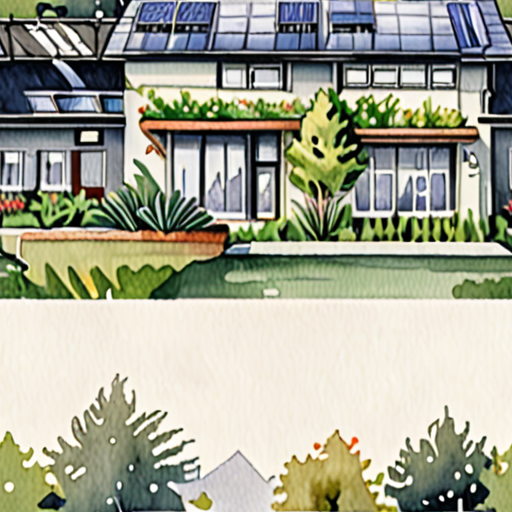As we continue to navigate the complexities of modern life, our homes have become more than just places to rest – they’re sanctuaries for our well-being, our families, and the planet. With the growing awareness of environmental concerns, many homeowners are seeking ways to transform their living spaces into eco-friendly havens, reducing their carbon footprint and promoting a healthier relationship between humans and nature. In this pursuit of sustainability, eco-friendly renovation has emerged as a vital aspect of home makeover strategies.

Examples of Eco-Friendly Construction Methods
We believe that sustainable building practices are essential for reducing our environmental footprint.
-
Sustainable Materials
One of the most effective ways to reduce waste and minimize environmental impact is by using sustainable materials in construction.
- Certified wood products, such as FSC-certified lumber, can help preserve forests and promote responsible forestry practices.
- Bamboo, a highly renewable resource, can be used for flooring, walls, and roofing.
- Recycled glass and plastic can be repurposed into countertops, tiles, and other decorative features.
-
Passive House Design
Passive house design emphasizes energy efficiency through careful planning and execution.
- Well-insulated buildings can reduce heating and cooling costs by up to 90%.
- Large windows and south-facing orientations can maximize natural light and heat gain.
- Airtight construction and mechanical ventilation systems can eliminate drafts and moisture issues.
-
Green Roofs
Green roofs offer numerous benefits, including reduced stormwater runoff and improved air quality.
- Plant species selection and soil depth can affect roof load-bearing capacity and maintenance requirements.
- Regular inspections and maintenance are crucial to prevent damage and extend roof lifespan.
- Green roofs can also provide insulation, reducing energy consumption and associated costs.
-
Net Zero Energy Buildings
Net zero energy buildings produce as much energy as they consume over the course of a year.
- Renewable energy sources, such as solar panels and wind turbines, can power buildings.
- Energy-efficient appliances and lighting can further reduce energy consumption.
- Smart building technologies can optimize energy usage and predict energy demand.
-
Modular Construction
Modular construction involves building components in a factory before assembling them on-site.
- This approach reduces waste, minimizes labor costs, and accelerates construction timelines.
- Modular units can be designed to meet specific climate and regional requirements.
- Standardized modules can facilitate easier transportation and installation.
-
Straw Bale Construction
Straw bale construction uses bales of straw as a primary building material.
- Straw bales provide excellent insulation, reducing energy consumption and associated costs.
- The natural, non-toxic properties of straw make it an attractive option for those seeking chemical-free building materials.
- Straw bale structures can be designed to withstand various weather conditions and seismic activity.
-
Earthship Construction
Earthship construction involves building homes using natural and recycled materials.
- Tire-filled foundations and earth-packed walls provide exceptional thermal mass and insulation.
- Recycled materials, such as cans and bottles, can be incorporated into the building envelope.
- Earthships often incorporate passive solar design principles to maximize natural light and heat gain.
-
Rammed Earth Construction
Rammed earth construction involves compacting a mixture of soil, sand, and gravel between formwork.
- Rammed earth walls can provide excellent thermal mass and insulation.
- The natural, non-toxic properties of rammed earth make it an attractive option for those seeking chemical-free building materials.
- Rammed earth structures can be designed to withstand various weather conditions and seismic activity.
-
Structural Insulated Panels (SIPs)
SIPs consist of an insulating foam core sandwiched between two structural facings.
- SIPs offer exceptional thermal performance, reducing energy consumption and associated costs.
- The structural integrity of SIPs allows for faster construction timelines and reduced labor costs.
- SIPs can be designed to meet specific climate and regional requirements.
-
Low-Carbon Concrete
Low-carbon concrete alternatives aim to reduce the environmental impact of traditional concrete production.
- Supplementary cementitious materials, such as fly ash and slag, can replace Portland cement.
- Recycled aggregate and industrial by-products can be used to reduce waste and conserve natural resources.
- Low-carbon concrete can be designed to meet specific strength and durability requirements.
Approaching Home Renovation with Sustainability in Mind
When it comes to renovating your home, there are several factors to consider, but one aspect that often gets overlooked is sustainability.
- One of the most effective ways to approach sustainable home renovation is to start with a thorough assessment of your current home’s energy efficiency.
- This can involve conducting an energy audit to identify areas where energy is being wasted and implementing measures to reduce energy consumption.
- Additionally, consider incorporating eco-friendly materials into your renovation plans, such as reclaimed wood, low-VOC paints, and sustainably sourced flooring.
- Another crucial aspect of sustainable home renovation is water conservation.
- This can be achieved through the installation of low-flow fixtures, greywater systems, and rainwater harvesting systems.
- Furthermore, consider incorporating renewable energy sources into your home, such as solar panels or wind turbines.
- These systems can significantly reduce your reliance on non-renewable energy sources and lower your carbon footprint.
- When selecting building materials, look for products that have been certified by organizations such as the Forest Stewardship Council (FSC) or the International Organization for Standardization (ISO).
- These certifications ensure that the materials meet certain environmental and social standards.
- Finally, consider working with a professional contractor who has experience with sustainable building practices.
- They can guide you through the process and help you make informed decisions about the materials and techniques used in your renovation.
Sustainable Materials for Home Renovation
There are numerous sustainable materials available for home renovation, including:
- Reclaimed wood: Salvaged from old buildings or trees, reclaimed wood reduces waste and preserves the history of the material.
- Bamboo: A highly renewable resource, bamboo is durable, resistant to pests and decay, and requires minimal maintenance.
- Cork: A sustainable alternative to traditional flooring materials, cork is soft, warm, and provides excellent insulation.
- Low-VOC paints: These paints emit fewer volatile organic compounds, reducing indoor air pollution and promoting healthier living spaces.
- Sustainably sourced stone: Choose stone products that have been harvested responsibly and with minimal environmental impact.
Renewable Energy Sources for Home Renovation
Incorporating renewable energy sources into your home renovation can significantly reduce your reliance on non-renewable energy sources and lower your carbon footprint.
- Solar panels: Harness the power of sunlight to generate electricity and heat your home.
- Wind turbines: Convert wind energy into electricity, providing a reliable source of power.
- Geothermal systems: Leverage the natural heat of the earth to provide heating and cooling.
- Passive solar design: Optimize your home’s orientation and layout to maximize natural light and heat.
Water Conservation Strategies for Home Renovation
Implementing water conservation strategies during your home renovation can significantly reduce your water usage and lower your utility bills.
- Low-flow fixtures: Install showerheads, faucets, and toilets that use less water per minute.
- Greywater systems: Collect and reuse wastewater from sinks, showers, and washing machines for irrigation and flushing toilets.
- Rainwater harvesting systems: Collect and store rainwater for non-potable uses, such as flushing toilets and watering plants.
- Air conditioning and ventilation systems: Design and install systems that minimize water usage and promote efficient cooling and ventilation.

Remodeling a House to Make it More Green
We believe that every homeowner has the power to create a sustainable and eco-friendly living space.
- Assess Your Home’s Energy Efficiency
- Upgrade to Energy-Efficient Appliances
- Install Solar Panels
- Improve Insulation and Air Sealing
- Conserve Water with Low-Flow Fixtures
- Use Eco-Friendly Building Materials
- Create a Sustainable Landscape
- Implement Smart Home Technology
- Monitor and Maintain Your Home’s Systems
Start by evaluating your home’s energy efficiency through a professional assessment or DIY audit. Identify areas where energy is being wasted and prioritize improvements accordingly.
Replace old appliances with energy-efficient models, which consume less energy and reduce greenhouse gas emissions. Look for products with the ENERGY STAR label, indicating they meet energy efficiency standards set by the U.S. Environmental Protection Agency.
Consider investing in solar panels to harness renewable energy and reduce your reliance on fossil fuels. Research local incentives and tax credits available for solar panel installations.
Add insulation to your attic, walls, and floors to minimize heat loss and prevent air leaks. Seal gaps around windows, doors, and ducts to prevent conditioned air from escaping.
Install low-flow showerheads, faucets, and toilets to reduce water consumption and lower your water bill. Consider installing a rainwater harvesting system to collect and reuse rainwater for non-potable purposes.
Select building materials with minimal environmental impact, such as reclaimed wood, bamboo, and low-VOC paints. Choose materials with high recycled content and those that can be easily recycled or reused.
Design a landscape that incorporates native plants, drought-tolerant species, and efficient irrigation systems. Use permeable pavers and rain gardens to manage stormwater runoff and reduce erosion.
Invest in smart home devices that monitor and control energy usage, temperature, and lighting. These technologies can help optimize energy efficiency and reduce waste.

Make Your Building More Eco-Friendly
As a homeowner, making your building more eco-friendly is a great step towards reducing your carbon footprint and contributing to a sustainable future.
- Assess Your Building’s Energy Efficiency
- Invest in Renewable Energy Sources
- Implement Water Conservation Measures
- Choose Sustainable Building Materials
- Create a Green Roof or Wall
- Optimize Your Lighting
- Reduce Waste and Implement Recycling Programs
- Maintain Your Building Regularly
Start by conducting an energy audit to identify areas where your building is losing heat or energy. This could include sealing air leaks, adding insulation, and upgrading windows.
Consider installing solar panels or wind turbines to reduce your reliance on non-renewable energy sources. These systems can help power your building and reduce your energy bills.
Install low-flow showerheads and toilets to reduce water waste. You can also install rainwater harvesting systems to collect and reuse rainwater for irrigation and other non-potable purposes.
Select materials that are sustainably sourced, recycled, or recyclable. Consider using reclaimed wood, bamboo, or low-VOC paints to minimize your environmental impact.
A green roof or wall can help insulate your building, reduce stormwater runoff, and provide habitats for local wildlife. Choose plants that are native to your region and require minimal maintenance.
Switch to LED lighting, which uses significantly less energy than traditional incandescent bulbs. Install motion sensors and timers to further reduce energy consumption.
Implement recycling programs for paper, plastic, glass, and metal. Reduce waste by composting food scraps and yard trimmings, and consider implementing a zero-waste policy.
Schedule regular maintenance checks to ensure your building’s systems are running efficiently. This includes HVAC, plumbing, and electrical systems.
By implementing these eco-friendly measures, you can reduce your building’s environmental impact, save money on energy bills, and increase its value.
Building a Cheap Eco-Friendly House
We understand that building an eco-friendly house can seem daunting, especially when considering the cost.
- One of the most significant expenses associated with building an eco-friendly house is the cost of sustainable materials.
- However, there are several ways to reduce costs without compromising on sustainability:
- Opt for locally sourced materials whenever possible.
- Consider repurposing or upcycling materials from old buildings or waste streams.
- Look into using reclaimed wood or bamboo for structural elements.
- Choose low-VOC paints and finishes to minimize indoor air pollution.
- Invest in energy-efficient appliances and lighting fixtures.
Sustainable Building Techniques
There are several sustainable building techniques that can help reduce construction costs:
- Passive solar design: This involves orienting the house to maximize natural light and heat gain during the winter months and shade during the summer months.
- Earthship construction: This technique uses natural and recycled materials to build homes that are energy-independent and self-sufficient.
- Rammed earth construction: This method uses compacted soil to create walls that are durable, insulating, and aesthetically pleasing.
- Cob construction: This ancient technique uses a mixture of clay, sand, and straw to create walls that are breathable, durable, and eco-friendly.
Eco-Friendly Materials
When selecting materials for your eco-friendly house, consider the following options:
- Bamboo flooring and paneling: Bamboo is a highly renewable resource that requires minimal maintenance and has a lower carbon footprint compared to traditional hardwoods.
- Recycled glass countertops: These countertops are made from crushed glass and can be customized to fit your unique style and needs.
- Sustainably sourced wood: Look for wood products certified by organizations such as the Forest Stewardship Council (FSC) or the Programme for the Endorsement of Forest Certification (PEFC).
- Low-carbon concrete: This type of concrete uses supplementary cementitious materials (SCMs) to reduce its carbon footprint and environmental impact.
Energy Efficiency
To minimize energy consumption and costs, consider the following energy-efficient features:
- High-performance insulation: Invest in high-quality insulation materials to reduce heat transfer and minimize energy losses.
- Double-glazed windows: Double-glazed windows can help reduce heat loss and minimize energy consumption.
- Solar panels: Consider installing solar panels to harness renewable energy and reduce your reliance on fossil fuels.
- Energy recovery ventilation systems: These systems recover heat energy from exhaust air and reuse it to warm or cool incoming fresh air.
Water Conservation
To conserve water and reduce wastewater generation, consider the following features:
- Dual-flush toilets: Dual-flush toilets use significantly less water per flush compared to traditional toilets.
- Low-flow showerheads and faucets: Low-flow showerheads and faucets can help reduce water consumption and minimize wastewater generation.
- Greywater systems: Greywater systems collect and treat wastewater generated from sinks, showers, and washing machines for irrigation purposes.
- Rainwater harvesting systems: Rainwater harvesting systems collect and store rainwater for non-potable purposes such as flushing toilets and irrigating plants.

What is the Most Environmentally Friendly Form of Building?
We believe that building sustainably is crucial for our planet’s future, which is why we’ve compiled a list of the most environmentally friendly forms of building.
- Bamboo Buildings
- Sustainable Wood Buildings
- Recycled Material Buildings
- Earth-Sheltered Buildings
- Prefabricated Buildings
- Cross-Laminated Timber (CLT) Buildings
- Straw Bale Buildings
- Rammed Earth Buildings
- Modular Buildings
- Green Roofs
Bamboo is a highly renewable resource that requires minimal water and pesticides to grow. It’s also incredibly strong and durable, making it an ideal material for building frames, flooring, and roofing.
Wood is a natural, renewable resource that can be sourced from responsibly managed forests. Look for certifications like FSC (Forest Stewardship Council) to ensure that the wood has been harvested sustainably.
Using recycled materials reduces waste and conserves natural resources. Consider using reclaimed wood, recycled glass, or plastic materials in your building project.
Earth-sheltered buildings are constructed into the ground, reducing the need for insulation and minimizing the building’s carbon footprint.
Prefabricated buildings are manufactured in a factory and assembled on-site, reducing waste and energy consumption during construction.
CLT is a type of engineered wood made from layers of wood pressed together. It’s a highly sustainable option for building walls, floors, and roofs.
Straw bale buildings use bales of straw as insulation, reducing the need for synthetic materials and minimizing energy consumption.
Rammed earth buildings use compacted soil and gravel to create walls, reducing the need for cement and other materials.
Modular buildings are constructed in a factory and assembled on-site, reducing waste and energy consumption during construction.
Green roofs feature vegetation and insulation, reducing energy consumption and creating habitats for wildlife.
Conclusion:
The most environmentally friendly form of building depends on various factors, including climate, budget, and personal preferences. However, incorporating sustainable materials and practices into your building project can significantly reduce its environmental impact. By choosing eco-friendly options, you’ll not only contribute to a healthier planet but also create a comfortable and sustainable living space for yourself and future generations.

0 Comments